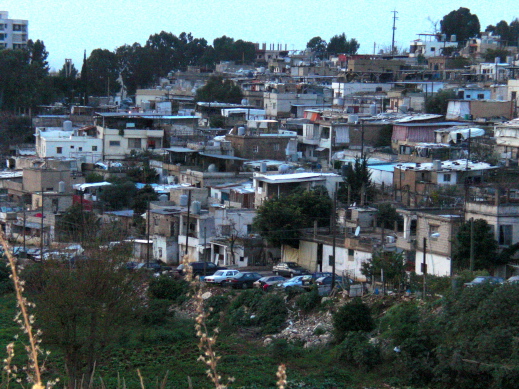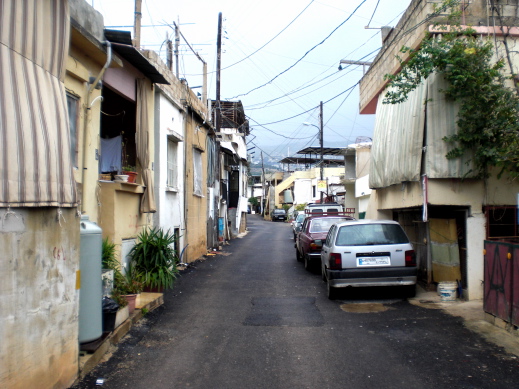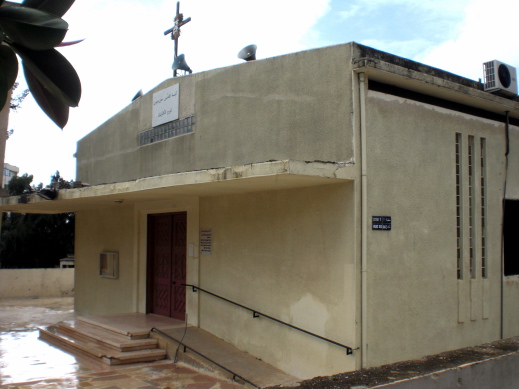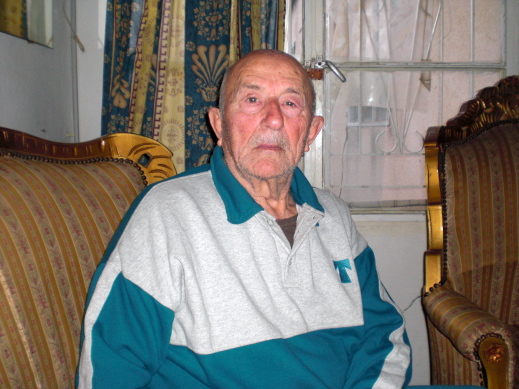
Established in 1956 and situated 12 km east of Beirut on a hill overlooking the luxurious seaside resort of Jounieh (on the Beirut-Tripoli highway), Dbayee is unique amongst the network of Palestinian camps in Lebanon for the Christian faith and identity of its residents. Indeed, it is the only all-Christian camp for Palestinian refugees in Lebanon.
The author has conducted field research in the Palestinian camps in Lebanon for nearly two years, and this winter he had the opportunity to spend an entire day in Dbayee where he interviewed all the key stakeholders and many ordinary residents of the camp.
Despite its physical and psychological estrangement from other Palestinian camps residents are no less attached to the ideas and aspirations of Palestinian nationalism. However, as the findings below indicate, their nationalism is expressed more through the mediums of culture and personal histories than the multitude of political discourses which comprise modern Palestinian nationalism.
Camp structure
Even after first impressions, the Dbayee camp – divided into four main streets with dwellings on either side – looks and feels strikingly different to the eleven other inhabited Palestinian camps in Lebanon [1]. Even though the prefabricated houses are as shabby and ramshackle as those found in other camps, the streets are clean and life generally seems more organised and pleasant.

There are two main reasons for this; first the population is very low, probably only 2,000 (despite official figures which indicate a larger presence), and second the Lebanese Government has ultimate responsibility over the welfare of camp residents. This is not the case in other camps, where on the basis of an agreement forged in 1969, the Lebanese Government generally stays out of the camps and keeps its profile in camp life to the very minimum [2].
In recent years the Lebanese Government has come under increasing fire for not interfering in camp life, especially in the larger camps, and particularly so in Ein Al-Hilweh, the largest camp of all, which has earned the dubious reputation of a “zone of unlaw” as a result of wanted felons seeking refuge there, safe in the knowledge they are beyond the reach of the law [3].
Dbayee’s residents are almost exclusively Christian, although there are reports that a Muslim family has recently moved into the camp. The majority (perhaps up to 60%) are Greek Catholics, but substantial numbers of Maronites and Greek Orthodox, and at least one Armenian Orthodox family live in the camp. There is also a small Latin catholic community which traces its origins to Haifa, and even smaller numbers of Protestants. The great majority of residents can trace their ancestry to the northern Palestinian village of Al-Bassa (Betzet in Hebrew, which is now situated in northern Israel).
In stark contrast to other camps – where symbols and icons of Palestinian nationalism, such as photos of political leaders and “martyrs” to the Palestinian cause, dominate the walls – the only symbols and icons on display in Dbayee are Catholic ones, some of which are unique to the Middle East. The locals claim they would like to be more expressive of their Palestinian identity but are afraid of retribution by the Lebanese Government.
The real reason may be a total absence of the Palestinian factions from Dbayee. In every other camp political factions; ranging from the Islamist Hamas to the Marxist Democratic Front for the Liberation of Palestine, maintain a visible presence and play a pivotal role in local popular committees. The lack of a popular committee is another distinguishing feature of Dbayee. Popular committees are tasked with managing the main issues in the camps and liaising with outside bodies such the United Nations Relief and Works Agency (UNRWA) and the Lebanese Government. Despite their ostensibly administrative functions, these committees are intensely factional and hostage to the complex politics played out in the occupied West Bank and the Gaza Strip. In most of the camps, there are two popular committees, PLO and Tahalof (Cooperative). The former is dominated by Fatah and the latter by the Islamists, particularly the Islamic Resistance Movement (Hamas).
The absence of factions and popular committees has less to do with the religion and the concomitant culture and life-styles of camp residents than the history of the camp. During the Lebanese Civil War of 1975-1990 the camp was in the territory of the largely Christian Phalangist fighters who generally harboured ill-will toward Palestinian refugees in Lebanon, irrespective of their religion. Indeed, many local residents claim that prior to the start of the Civil War the PLO maintained a vibrant presence in the camp but was forced out by the Phalangists. Following the end of the Civil War the Lebanese Government exerted its authority over the camp thereby deterring Palestinian political organisations from re-establishing a presence in Dbayee.
In the absence of political organisations and a popular committee, camp residents manage the affairs of the camp with the help of UNRWA and the Lebanese Government. There is ostensibly a camp manager, one Mohammed Ayoub, but residents complain that he only visits the camp once every week and even then does nothing substantial by way of improving residents’ lives. The most striking feature of the camp manager is his religion (Ayoub is a Muslim) and the fact that he lives in far away Ein Al-Hilweh camp, situated on the outskirts of Saidon. Whilst camp residents do not mind Ayoub’s Islamic faith they question why UNRWA and the Lebanese Government have to appoint an outsider as camp manager. It seems this is a long-standing tradition in Dbayee, for Mr Ayoub’s predecessor, Hassan Ayoub (no relation) was also from Ein Al-Hilweh.
The church plays an important role in camp organisation and the social life of camp residents, even though many residents privately admit they are not very religious, despite adorning the interior and exterior of their homes with Catholic symbols. There is a single Catholic church inside the camp, St. George, an impressive building at the very centre of Dbayee. Dbayee has a dedicated (albeit non-resident) priest, one Andre Najem, a Lebanese, who makes the point of visiting the camp often.

There is a Maronite church just outside the camp, right atop the hill. The large and ostentatious St. Joseph church mostly caters to local Lebanese Maronites, but camp residents are also welcome to attend. According to some accounts St. Joseph owns most of the land in Dbayee, a cause of resentment for some camp residents.
Although technically speaking Maronites are Catholics, camp residents, as well as local Maronite communities, make a point of clearly distinguishing between Greek and other Catholics and Maronites. The distinction is made for mostly political reasons, and issues related to political and national identity, than to differences in religious doctrines and beliefs.
Like all Palestinian camps Dbayee is plagued with a range of infrastructure problems. The biggest problem of all is the contaminated water. The man who does more than most to combat the problem is one Youssef Nemeh. A short bespectacled man in his early to mid 60s, Nemeh has an impressive command of the English language. Long retired, he used to work as a teacher of English and Arabic at several Evangelical schools in Beirut and Saidon. Nemeh blames the paucity of efforts in combating water contamination on UNRWA lethargy and corruption. At one point Nemeh was so exasperated with UNRWA that he took a sample of water to an independent testing centre in Jounieh. He produces a document that states the test was carried out on 28 July 2005, the result of which showed evidence of “fecal coliformes”. The document concludes that the water is “non-drinkable”. To this day camp residents continue to use water that has been independently judged to be highly contaminated and in any case non-drinkable.
Imagining Palestine
Dbayee does not come across as a bastion of Palestinian nationalism. Aside from the absence of political factions and the associated symbols of Palestinian resistance, many camp residents (despite their initial denials) have acquired Lebanese nationality. This makes them exempt from the stifling restrictions imposed on Palestinian refugees, such as the prohibition on owning property and holding a decent full-time job. Moreover, many camp residents have strong ties to the world outside Lebanon, with many having at least one relative in countries such as France, Canada and the United States. Yet despite having acquired Lebanese nationality (and ostensibly having the right to travel) and despite having relatives with well-established lives outside Lebanon who can help them leave the country, the majority have decided to stay put in Dbayee.
Notwithstanding the lack of visible national symbols (and the concomitant nationalistic rhetoric so common in Palestinian communities the world over) the “idea” of Palestine looms large in the imaginations and hearts of camp residents.
Asad Zoerob is a tall, good-looking man in his late 30s or early 40s. A baker by trade, he still finds time for local activism, such as combating water contamination and other infrastructure problems. Zoerob claims his Palestinian identity was reinforced by the prejudices he encountered from a minority amongst Lebanon’s Christian communities. He says he is always eager to find “friends” in the occupied West Bank and the Gaza Strip, usually through the internet. He expresses qualified support for a variety of Palestinian factions, including the Islamic Resistance Movement (Hamas) which he claims treats Christians in the Gaza Strip “well”.
The relationship between Palestinian Christians and Lebanese Christians is complex and subject to a great deal of misunderstanding. For instance, Palestinian Muslims in Lebanon often claim their Christian compatriots got a much better “deal” from the Lebanese state (particularly before 1975 during the heydays of Maronite political ascendance) on account of their faith. They point to citizenship rights, and the fact that at least some Christians were granted Lebanese nationality (ostensibly to boost Christian demographic strength in Lebanon) almost immediately whereas more than 60 years on the great majority of Palestinian refugees are struggling to attain the most basic of human rights, such as the right to own property.
However, the Christian residents of Dbayee are quick to challenge this description, pointing to a general Maronite dislike of Palestinian refugees, irrespective of religion. They claim that Maronite prejudice toward Palestinians – stemming from the onset of the Lebanese Civil War – continues to linger and even now adversely affects their lives. But this contention sits uneasily with widespread evidence of intermarriage between Dbayee residents and local Christians, including Maronites. Moreover, a substantial number of Lebanese Maronites (accounts differ on the extent of numbers) actually live inside Dbayee camp.
Abu Nasser represents a different generation altogether. Born in 1927 in Al-Bassa his life of exile and emigration mirrors the collective tragedy of the Palestinian people. Vigilant, active and friendly, he sits back to give a detailed account of his life. After being driven out of his village by Zionist forces in 1948, he and his family fled to Lebanon [4]. They stayed in a variety of camps before moving to Dbayee in the late 1950s. From 1952 to 1968 he was an UNRWA teacher in various camps. In 1968 he immigrated to Toronto (Canada) and stayed there for 10 years. He returned to Dbayee in the late 1970s and has stayed put since. Asked if he still thinks he can one day return to his ancestral village in northern Palestine (Israel) he gives an uncharacteristically lethargic smile.

Broadly speaking, the residents of Dbayee subscribe to a folk-like or countryside form of Palestinian nationalism. This doesn’t mean that like Palestinians the world over they don’t dream about a Palestinian state, but their nationalism is far less involved with the details of modern Palestinian resistance. This has much more to do with their physical and psychological isolation than their religion, especially since Palestinian Christians in the occupied West Bank and the Gaza Strip are no less political than their Muslim compatriots.
The real or perceived prejudices inflicted on camp residents by nearby Lebanese communities has reinforced the residents’ Palestinian identity – and despite the lack of physical and legal barriers – prevented their physical, cultural and economic integration into the surrounding landscape. Ironically – despite the camp residents’ isolation from other Palestinian communities in Lebanon- Dbayee may prove to be the last camp to be “integrated” into the socio-economic (if not cultural) fabric of Lebanese society.
Notes
[1] Despite reports to the contrary there are in reality only twelve “inhabited” Palestinian camps in Lebanon. These are: Dbayee (Beirut), Shatila (Beirut), Mar Elias (Beirut), Bourj Barajneh (Beirut), Rashidiyah (Tyre), Bourj Shemali (Tyre), Al-Buss (Tyre), Mieh Mieh (Saidon), Ein Al-Hilweh (Saidon), Jalil (Baalbeck), Beddawi (Tripoli) and Nahr El-Bared (Tripoli). Note that Nahr El-Bared was destroyed in the fighting between the shadowy Fatah Al-Islam group and the Lebanese army in May-September 2007. However, small groups of people continue to live on the edge of the camp.
[2] The Cairo Agreement of 1969 put the Palestinian camps in Lebanon under the control of the Palestine Liberation Organisation and effectively banned the Lebanese army and security forces from entering the camps without prior permission from the PLO. The Lebanese Government unilaterally rescinded this Agreement in the late 1980s but in practice it has been extremely reluctant to enter the camps or interfere with them in any significant way, barring national emergencies, such as the outbreak of fighting in the northern Nahr El-Bared camp in May 2007.
[3] To learn more about Ein Al-Hilweh refer to the author’s “Ein Al-Hilweh: A fruitless search for Al-Qaeda”, January 7, 2010, http://www.atimes.com/atimes/Middle_East/LA07Ak02.html.
[4] Al-Bassa was occupied by the Haganah paramilitary organisation in May 1948, despite the fact the village was situated in territory apportioned to the Arab state under the 1947 United Nations partitions plan.
Mahan Abedin is a research fellow at the New Delhi-based Institute for Defence Studies and Analysis. Previously he has worked with numerous think tanks, including the Washington-based Jamestown Foundation and the London-based Centre for the Study of Terrorism. He has also been active in journalism, having worked for the Beirut-based Daily Star and most recently the Irbil-based AK News Agency where he was chief editor of the Persian and English sections. Born in Iran, but raised and educated in the United Kingdom, Abedin is a frequent traveller to the Islamic Republic where he is a consultant to independent media.
© 2010 Mahan Abedin